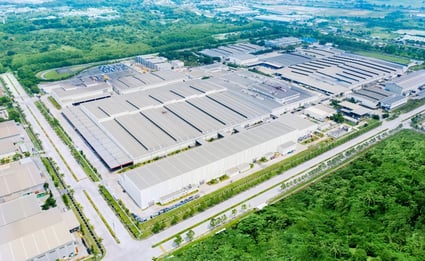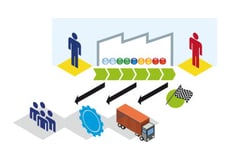Agile vs. Lean Manufacturing: What’s the Difference?
Brian Hoey - April 16, 2019

If you work in supply chain management or manufacturing, you probably hear the words “agile” and “lean” thrown around a lot. Both of them seem to be good things, and they both appear to be ways of cutting costs and improving operations, but beyond that one sometimes feels like they’re being used interchangeably. To make matters worse, both terms seem to have been coopted by the tech industry, making it harder than ever to figure out what each of these terms actually means in an industrial context.
Luckily, we’re here to help. In this post, we’ll give you a rundown of the different processes and philosophies that these terms refer to, what distinguishes one from the other, and how each one relates to the challenges that face modern manufacturers.
Lean Manufacturing
For starters, let’s talk about lean manufacturing. Lean as a concept predates agile; many see agile as an outgrowth of lean, which may add to the confusion in terminology. But on a very basic level, going lean means organizing your processes around the elimination of waste. In an industrial context, this tends to mean reducing buffer stock in your inventory, eliminating non-value-additive production flows and machines from your factory floor, and generally cutting out any steps in the manufacturing process that don’t explicitly add value for your customers and your business. You can easily imagine that going lean is not as easy at it sounds. Why? Because by eliminating buffer stock, for instance, you take on a higher level of supply chain risk, owing to the lack of wiggle room if something unexpected occurs. Thus, lean initiatives only succeed when cost-cutting and waste elimination are accompanied by the development of lean heuristics that ensure that your production processes are optimized to respond effectively to disruptions.
How do supply chain managers implement those heuristics? For starters, they have to gain considerable visibility and insight into each touch point on the production chain. Only when you understand each process well enough to not only evaluate it but predict the outcomes of potential changes to it can you safely reduce waste. This level of visibility can be hard to attain; some businesses are able to achieve it by improving their IT infrastructure to create a more open, interoperable environment. Others use advanced prescriptive analytics to uncover potential process improvements. In either case, it’s crucial to make sure that your baseline workflows are extremely strong before you start paring things down.
Agile
The criticism that’s been levied against lean manufacturing in the past is that, because it demands such strong process fundamentals underpinning production paradigms, it can actually make manufacturers less flexible. Lean has a reputation for being ideal in industries with predictable demand cycles, little product variety, and long product lifecycles—but potentially limiting for more volatile sectors. Agile, for its part, seeks to remedy this situation by accounting for the inherent uncertainties of creating and shipping out a product of any kind.
What does this mean, exactly? Well, where lean focuses most of its efforts on the elimination of waste, agile manufacturing’s primary concern is with meeting customer needs as quickly as possible. When building a product for instance, the goal isn’t to roll out a finished product that has been meticulously perfected in every detail, but to develop something with input from consumers that addresses their most pressing needs and concerns. You can see why this concept might be more sensibly applied to things like software development, where you can refine a product over many iterations—but there are important lessons here for manufacturers as well. By emphasizing change and adaptability, you can prepare yourself to more effectively meet customer needs in markets, even like auto manufacturing, where buyers increasingly demand customization and ever-shorter lead times.
Let’s draw the distinction between the two out a little bit further by way of an example: where a lean manufacturer might reduce inventory levels in order to cut costs, an agile, manufacturer might be more inclined to retain a buffer stock, such that they wouldn’t be unprepared in the event of an unexpected demand spike. Instead of a set of largely analytical workflows for identifying waste, your typical agile manufacturer might put more of a focus on interpersonal communication in order to efficiently reorganize processes on the fly. This might not help as much with cost-cutting, but when a challenge arises it can help you take the shortest route from point A to point B, so to speak, without forcing you to work within long-established existing processes that might not be optimized for new situations.
Agile-lean
Now the tricky part: while agile and lean are often spoken about in oppositional terms (with agile processes arising as a response to lean manufacturing), the two aren’t necessarily incompatible. A factory can be either, both, or neither. This begs the question: how effectively can a company really eliminate waste from its processes while keeping those processes dynamic and malleable? Well, it’s not easy, but it is possible—and it starts with end-to-end supply chain visibility. Why? Because in order to understand the most efficient ways to implement flexible processes, you need to have a robust understanding of all of the resources at play in each decision. This means working to optimize things like sourcing as far upstream as possible, in order to remove uncertainty from otherwise volatile systems. Likewise, it means improving your forecasting capabilities in order to identify potential market and demand changes far enough in advance to remain lean while approaching them in a dynamic way.
This agile-lean model of manufacturing might be a lofty goal, but it represents the synergistic relationship that agile and lean principles can have within an organization. By introducing new data streams from every touchpoint on the supply chain—and building in the capacity to analyze them with AI or advanced analytics—you can simultaneously eliminate waste and maintain organizational flexibility. Doing so will likely require things like IoT devices that can transmit factory floor data back to your centralized planning infrastructure, not to mention integrated IT systems that seamlessly connect you to your distributers and suppliers. While this may require some initial investment, the payoff will come in the form of reduced costs and improved responsiveness.
If you want to learn more, download your guide to Transformation of Manufacturing Processes.
In this Guide you will learn:
-
Emerging Challenges in the Modern Truck/Automotive Industry
-
How Can Global Companies Adapt to These New Realities
-
How Decentralized Digital Systems Power Smarter Planning Processes
-
How flexis Can Support Flexible Supply Chain Transformation
LATEST POSTS
- Understand Circular Economy in The Manufacturing Industry
- How Can Industry 4.0 IT Integration Be Achieved Smoothly?
- The Significance of Order Sequencing in Discrete Manufacturing
- How to improve your Supply Chain Management: The Power of Control Towers
- Optimizing Human Resource Scheduling in Manufacturing: A Technological Approach



